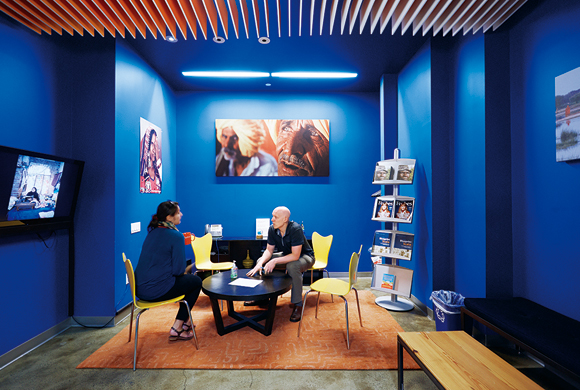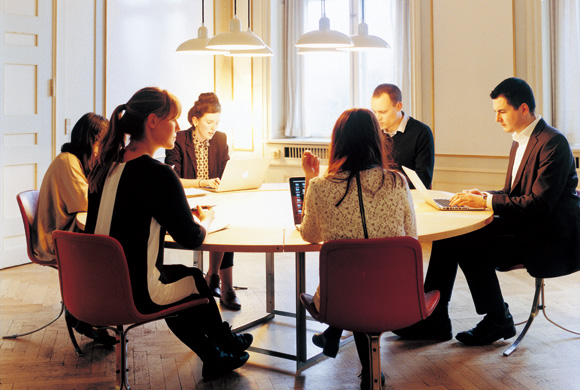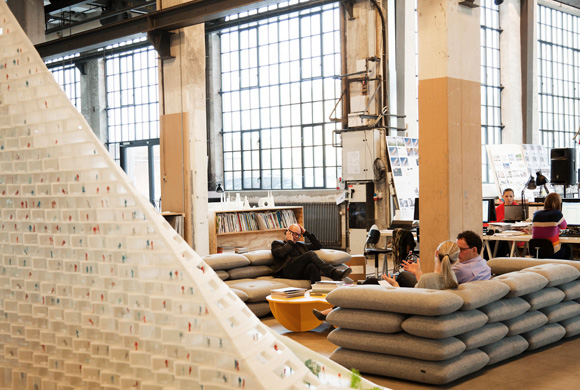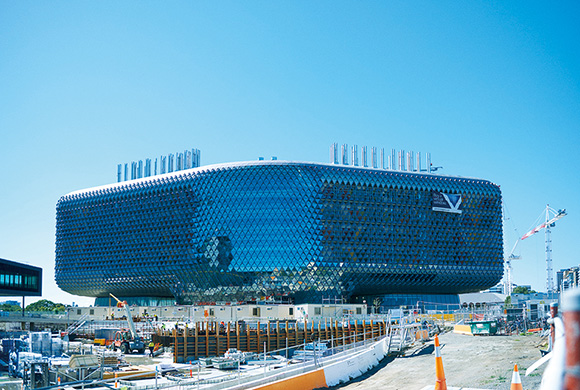Workplace
Apr. 8, 2019
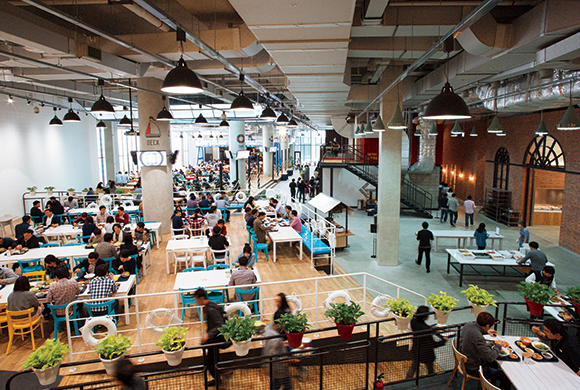
Respect for Quality of Life and the Future of Games
Game Developer and Publisher
[NHN Entertainment] Seoul, Republic of Korea
In August 2013, the game division of NHN became an independent company, NHN Entertainment. Along with its affiliated companies, it has become a global game company with assets reaching one trillion won (approx. ¥98.8 billion, as of August 2014). The company is also known in Japan for the online game portal site Hangame.
The company moved into an office building with ten floors above ground and one underground called the Play Museum, where the brand team works on everything from concept creation to design. In addition to daily work on products and service, the department overseas offline posters, advertising, stationery used in-house and all other company branding tools.
Having said that, though, there are few companies that do not outsource office design but entrust it to the internal brand team. Marketing Manager Sung-Yul Yang explains the reasons for this.
“What we have here is not a simple office, but a place that we feel should be the point of reference for our service and products,” he says. “And it’s the employees who are the core of producing both of these. If that’s the case, it’s inevitable that people should work in an office space that has the same level of detail and quality as the products and services.”
There is one more clear goal for the Play Museum: to resolve the management issues the company faced regarding the speeding up of development. To put it another way, the company wanted to be able to release more desirable products at a faster pace than ever before.
As a result of the switch in the game industry from a focus on PCs to mobile, the cycle from development to product release has greatly increased, and the competitive edge is not possessed by major companies but by the small and mid-size game studios that can respond more flexibly. NHN not only focuses on large-scale games with a one to two year production period, but also increasingly on smaller mobile games created by teams of 10 staff people or less.Releasing more desirable products at a faster pace than ever before is the challenge faced by all game manufacturers.
“The idea that ideas are the basis of the game is something where we are similar to other companies,” Mr. Yang says. “At any rate, this is an era in which the speed of development determines everything.”
 The company is located in the Pangyo Techno Valley, a district created by government policy and home to many game, web and telecommunications companies. Special tax incentives are provided for locating here.
The company is located in the Pangyo Techno Valley, a district created by government policy and home to many game, web and telecommunications companies. Special tax incentives are provided for locating here.
Established: 2013
Sales: Approx. ¥ 65.76 billion (as of 2013)
Net income: Approx. ¥ 18.33 billion (as of 2013)
Employees: 2,333 (as of Aug 2014)
http://www.nhnent.com

The center staircase, at the heart of the building. It connects the separated floors, and was designed to very naturally allow people to build better understanding.
Then new office space was created. With the creation of the Focus Group Test (FGT) room and the Sound Photo Studio within the building, they could really be called a global game company. The FGT room is a facility that allows the company to bring a number of gamers together to test games before release. The Sound Photo Studio is where video and sound production work can be carried out. There’s no doubt that these facilities are intended as part of the development speed-up process.
But the most important thing for the company is increasing the speed of communications. Most of the Play Museum, in fact, has been designed toward that goal. Mr. Yang says that staircase in the center of the Play Museum is the biggest feature of this in the building. It acts as a catalyst, connecting employees who otherwise are separated onto different floors. But how does it do this?
In the previous office, the staircase was an emergency exit set off in a corner of the office. From the start, too, employees working in high-rise buildings have very little opportunity to move between floors, and employees working on different floors have little opportunity to meet. Because of this, communication is largely by email or telephone. Just to have a short meeting, it becomes necessary to reserve a meeting room.
“I saw this as a very inefficient way of doing business,” Mr. Yang says. “It wasn’t easy for people to simply feel like getting together for a discussion.”
To resolve this problem, the center staircase was created. The staircase is set in the center of the office to encourage the frequency of its use. Here it is very easy to meet employees from other floors. Just by chance, meetings are often held at the landings of the staircase. The result is that the speed at which employees can come to mutual understandings or handle business activities has greatly increased.
Along with invigorating communications, there has also been an increase in the speed of business activities. Hive is a box-shaped area dotted with small meeting rooms created with that increased speed in mind. For example, Hive can be linked to riding an elevator as it moves down. People who happen to meet by chance might want to move to a nearby Hive to sit down and talk. Near the center staircase are a refrigerator, toaster, coffeemaker and Hives, all of which are there to encourage casual communication among employees.
A socially horizontal space has been created, so there is little sense of a superior/subordinate hierarchy. A meeting room on the 10th floor is called the Super-Flat Meeting Room. Ring seating means that there is no head chair or subordinate chair, and discussions can be held with all participants at the same level. It’s not a place where the discussion is vertical and dominated by superiors, but where people of varied ages and positions can join in discussions, for meetings that are creative and constructive and which reflect the company culture.
“Maybe when people look into the company from the outside, it looks like a free place,” Mr. Yang says. “But I don’t think that we have any particular kind of freedom here. The autonomy of employees is very important, but we are a regular company where people clock in and clock out, take vacation days, and where there are rules that people should obey. Some of the keywords that show our corporate culture include a lack of formalities and ostentation, and honesty. In communications, frankness and simplicity are important. These give birth to creativity, and, I believe, become the seeds for new games.”

Mounted above the desk is the Leaf; this can be used when employees want to concentrate and block of the view from others around the employee. The Leaf units were distributed to employees before the spin-off of the company.

NHN Entertainment
Head of Design
Sung-Yul Yang

Super-flat meeting room. Befitting a game company, it has a bright, casual feeling enhanced with modern art.

The Focus Group Test room. Before market release, games are tested by a number of players.

Sound Studio. Video and sound production can be efficiently carried out here.
About half of NHN’s employees are in the most of them are 20s-30s. Their jobs include development, planning and design, but more than half of them did not major in these areas in school. The one thing that does bring them all together is a love for games. The concept behind the Play Museum was to provide this young, varied group with a space that meets their lifestyles.
One example is the full range of welfare facilities provided by the company. The second-floor Utility Zone uses fragrant cypress wood to help heal mind and body. There is also a room for nursing mothers, and a childcare facility. About 40 percent of the employees are women—higher than the industry average—and these facilities may be one reason for this.
However, one thing sets this company apart more than the welfare facilities. “The main thing is the dynamism and creativity,” says Jong-Min Kim of the PR Team. “People won’t be able to have the creative ideas that back product development without the space that can support this. For me, it’s great fun to be here in the office!”
Heading down in the Play Museum to the B1 floor is the appearance of the harbor-motif cafeteria Port 629. The concept is complete down to the staff uniforms, designed to look like those of naval officers. The 629 number comes from the building address at 629 Sampyeong-dong. The message implied is that the company set off on a new journey when it moved to 629.
All meals here are free, and there are normally two daily specials each day. Apart from meal times, this is also a lecture space that can hold 100 people. Along with it is an entertainment area where employees can enjoy basketball, badminton and other sports and arcade games. These are spaces that were planned to encourage friendship and mutual understanding between employees.
Chairman Jun-ho Lee is a passionate sports fan, there has been much thought put into the health of employees. One way Mr. Iee’s vision has been realized is the indoor bicycle parking area. This makes bicycle commuting possible for the employees, with some 100 bicycles able to be stored here. By hanging bicycles from the ceiling, even more can be accommodated here.
The staff have priority for the in-house bicycle parking. Simple bicycle inspections and repairs are available here at no charge, and the staff can even answer questions from those who want to buy a new bicycle. He also purchased 20 expensive bicycles using his own money which he then gave to employees. After he did this, the number of employees commuting to work by bicycle grew.
In the previous office, employees were concerned about the danger of theft and rain damage at the outdoor bicycle parking area. The idea for the indoor parking area in the new office actually came from the employees.
No expense was spared in the investment in employee health, from the use of charcoal as part of the prevention of sick house syndrome, to the unique Chika Chika Room area for tooth brushing.
“Our work is focused on game development,” Mr. Yang says. “Because of this, the work style is not one where people are working on fixed working hours.
Sometimes it’s unavoidable that people have to work both day and night. That’s why the company has prepared a range of health-related facilities. Conversely, when we’re making decisions, if there is something that we believe that will be harmful for the employees’’ health, this are the things that are eliminated right away.”
Consultancy for Work Style:in-house
Interior Design:in-house, Eomji House CO.LTD
Architect:Heerim Architects & Planners
From WORKSIGHT 06 (Oct. 2014)

A small stream flows on the roof. It’s common to see employees strolling here, enjoying their rest times. Some employees also hold workshops here, using the beam projector.

The fitness room, available to all employees. Those who wish can enjoy personal training here. The service is not free, but the fees are paid in part by the company.

Room for nursing mothers. A childcare facility has also been created in the vicinity of the Play Museum.

To assist employees frequently traveling overseas, the company has its own in-house travel agency. After joining the company, employees and their families automatically have insurance.

The Chika Chika room, a special space where employees can brush after meals. In the past, employees often would simply use the sinks in the rest rooms for brushing, but the company knows that this can be annoying to other people using the rest room. There are separate spaces for men and women.












